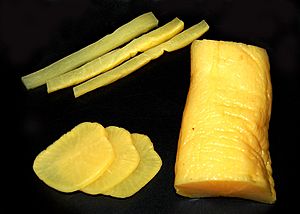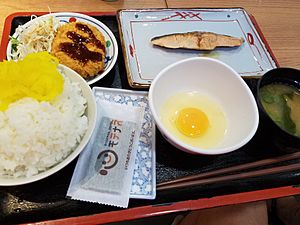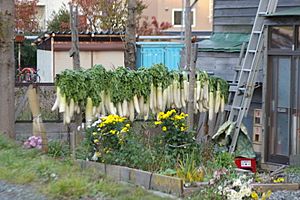Takuan facts for kids
Takuan (Japanese: 沢庵), also called takuwan or takuan-zuke (沢庵漬), is a popular type of pickled daikon radish. In Korean cuisine, it's known as danmuji (Korean: 단무지). This tasty pickle is a common part of traditional Japanese cuisine. It's often served uncooked with other kinds of tsukemono (which means 'pickled things'). People also enjoy takuan at the end of meals because it can help with digestion.
Contents
The Story of Takuan
In Japan, a famous Buddhist monk named Takuan Sōhō (who lived from 1573 to 1645) is often given credit for creating this yellow pickle. That's why it's named after him!
How People Enjoy Takuan
Before serving, takuan is usually rinsed with water to wash off any extra brine (salty water). Then, it's sliced into thin pieces. People eat it as a side dish during meals or as a snack during teatime.
Thin strips of takuan are often used in Japanese bento boxes. Sometimes, traditional takuan that has been sun-dried and pickled in rice bran might be stir-fried or braised. This happens especially if it's older and has become a bit sour.
You can also find takuan in some sushi rolls. For example, shinkomaki is a sushi roll with only takuan. Torotaku-maki is another type that includes both fatty tuna (called maguro) and takuan.
Takuan in Korea
In Korea, takuan is called danmuji (Korean: 단무지). It's a very common banchan (which means side dish). You'll often find danmuji served with bunsik (light meals or snacks) and with Korean Chinese dishes.
How Takuan is Made
Making takuan the traditional way involves a few steps. First, a daikon radish is hung in the sun for several weeks. This helps it become dehydrated and flexible.
Next, the dried daikon is placed in a special pickling crock. It's then covered with a mix of salt, rice bran, and sometimes sugar. Other ingredients like daikon greens, kombu (a type of seaweed), chilli pepper, or dried persimmon peels might also be added. A heavy weight is placed on top of the crock. The daikon then pickles for several months. The finished takuan usually has a yellow color and a strong, unique smell.
Most takuan made in large factories uses salt or syrup to make the drying process faster. They also often add artificial color to make it look more appealing.
In Akita Prefecture in northern Japan, there's a special kind of takuan called Iburi-gakko. This type is smoked instead of sun-dried before it's pickled.
Images for kids
-
Raw onion, danmuji, and chunjang (sweet bean sauce) are typically served in Korean Chinese restaurants
See also
 In Spanish: Takuan para niños
In Spanish: Takuan para niños






